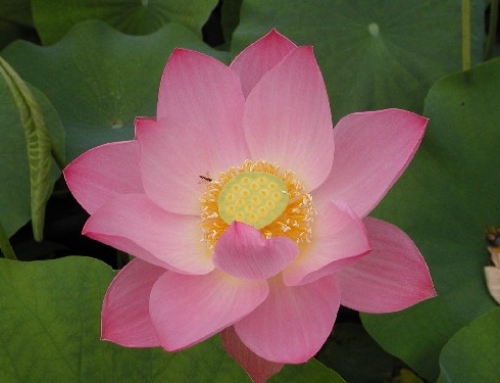http://www.watergarden.org/Pond-Info/Winter-Fish-Care
Feed fish appropriately. As water temperatures drop below 50 degrees you should stop feeding altogether until spring when the temperature remains above 50. As organics decompose in the pond, they can produce toxic gases that could be trapped in the pond if it is covered by ice for more than a few days. It is important to keep at least a small area free of ice so that the gases can escape. One of the easiest ways to do this is with a floating pond de-icer. This device floats in the pond and has a built in thermostat to turn the heating element on when the water temperature drops below 40 degrees. This keeps a small pond from freezing solid allowing you to keep your fish alive.
How to Care for a Goldfish Pond During the Winter Months
http://animals.mom.me/care-goldfish-pond-during-winter-months-4409.html
Goldfish survive below-freezing temperatures by going into hibernation, but only if they receive plenty of oxygen. Keeping ice off part of your pond is crucial. The fact is, keeping your goldfish alive outdoors during the winter requires year-round diligence — but not a lot of your time.
Seasonal Diet
Keeping your goldfish alive through the winter starts in the summer. Give a high-protein food to help them build up fat stores that will sustain them during hibernation. When the weather cools below 60 degrees Fahrenheit in the daytime, change the food to an easy-to-digest wheat germ variety. When the weather falls below 50 degrees, the fish are unlikely to need food. If you see food floating after your cooler-weather feedings, stop feeding until the weather warms.
Ice
Ice is an enemy in winter. If your pond is at least 3 feet deep, it’s unlikely to freeze completely. However, even a thin layer of ice covering the surface traps harmful gases inside and keeps oxygen out. If those gases aren’t allowed to escape and be replaced by oxygen, the fish will suffocate. Solve this problem by pouring warm water in one section of the pond to melt the ice or by placing a pan with hot water on top of the ice to melt through it — be sure to remove it once the hole is melted. The hole doesn’t need to be large. About 12 inches in diameter is usually sufficient. But it needs to remain open all winter. If you notice the fish braving the colder waters to swim near the hole, this means not enough oxygen is in the lower levels. The hole needs to be bigger.
Deicing
A floating deicer can help you keep an air hole open in the ice of your pond. It contains a heating element to keep ice from forming in the area immediately around the device. It won’t protect the entire surface or heat the water for the fish, but it’s effective at keeping small areas ice-free. If you’re leaving in the pond plants that have roots underwater, placing a deicer near the stems can keep the ice away from the plants while it leaves an air hole in the ice.
Plants
Bring potted tropical plants such as birds of paradise indoors to help them survive winter. Even if the foliage dies, it often comes back from the tubers or roots when the weather warms, when you can move the pots back to your pond. Many plants that have roots underwater, such as water lilies, can survive cold winters and don’t need to be removed, even if they’re in pots underwater. Clean out the pond to remove as many leaves, twigs or other debris as possible. As these decompose in the water, they remove oxygen that the fish need.
Filters and Pumps
Many pond pumps and filter systems aren’t designed to work in cold temperatures. If your pond uses a filter or pump, check your system’s specifications to find its lowest operating temperature, and turn it off when it gets too cold for the system to operate properly. If you let it run when the weather is too cold, it can freeze and ruin. If you have a system that can run throughout winter, make sure it pulls water up instead of moving water from the surface to the bottom. Deeper areas of the pond tend to stay warmer than the surface, and your goldfish will congregate in the warmest areas. If your pump moves cold water from the surface into the deeper areas, your fish could die.
How to Keep Koi Fish in a Pond During Freezing Weather
https://www.todayshomeowner.com/how-to-keep-koi-fish-in-a-pond-during-freezing-weather/
Ice by itself is not dangerous to koi, as long as your pond is deep enough not to freeze completely (3-5 feet or more). The danger to fish comes with the reduced oxygen and increased toxic gases caused by the sealed over water surface.
While you could move your fish and plants to a temporary indoor tank for the winter, or install pond heaters that use a lot of energy, in many cases you can overwinter your fish outdoors with a little care. Keep in mind these tips:
- Aeration: Have an aerator running in your pond at all times to keep the water stirred and promote the exchange of gases. An aerator is a lot more economical than a pond heater, and it will oxygenate the water while reducing ice build up.
- Ventilation: If you’re aerating the water, all you need is a small hole or two for the bubbles to escape. You don’t need to remove the rest of the ice from the surface.
- Balance: Koi (and many other fish) go into a sort of dormancy in the winter, using less oxygen and naturally settling to the bottom of the pond where the water is warmer. Your aerator should gently stir the water without upsetting this natural balance. Go for a steady stream of bubbles, not a rolling “boil” or strong current. If your pond is 4-5 feet or deeper, put the diffuser at the middle of the depth range (not the deepest part) so that the fish can retreat to less-disturbed deeper waters if needed.
- Ice: Don’t break the ice in your pond by hitting it, since the force can cause shock waves that may hurt the fish. Keep an eye on your ventilation hole and remove any thin ice before it becomes thick and hard. If necessary, you can sit a full, hot teakettle on top of the ice until it melts a hole. Otherwise, let it snow! The snow, ice, and surrounding earth will help insulate your pond from the frigid air.
- De-Icer: If your pond threatens to freeze completely, you may need to install a de-icer to keep at least part of the water above freezing. Your fish will need a few feet of liquid water in the pond throughout the winter.

